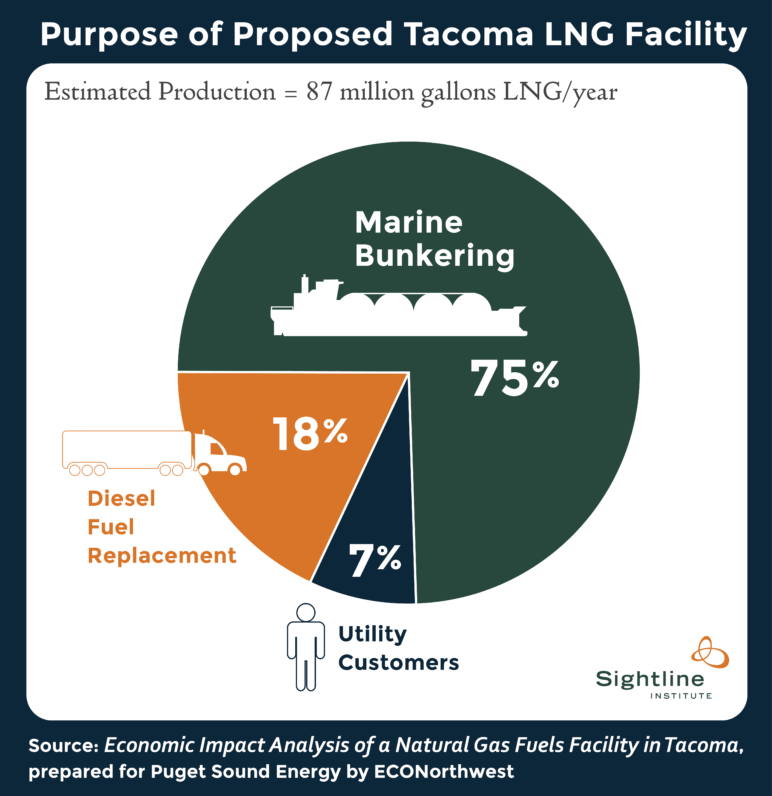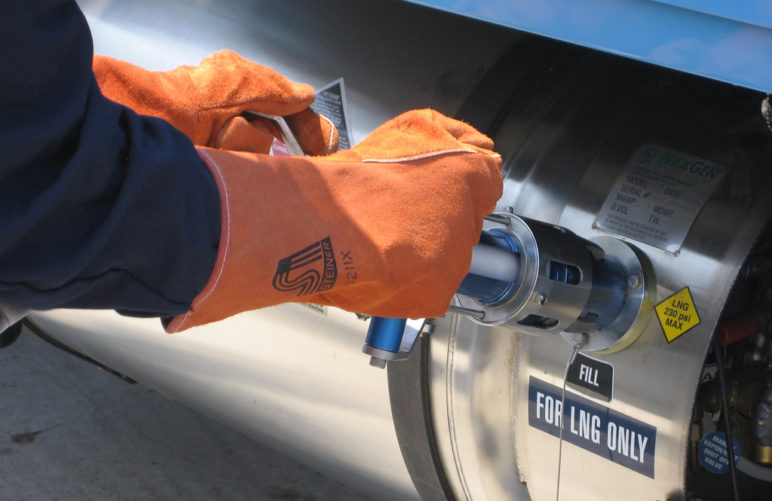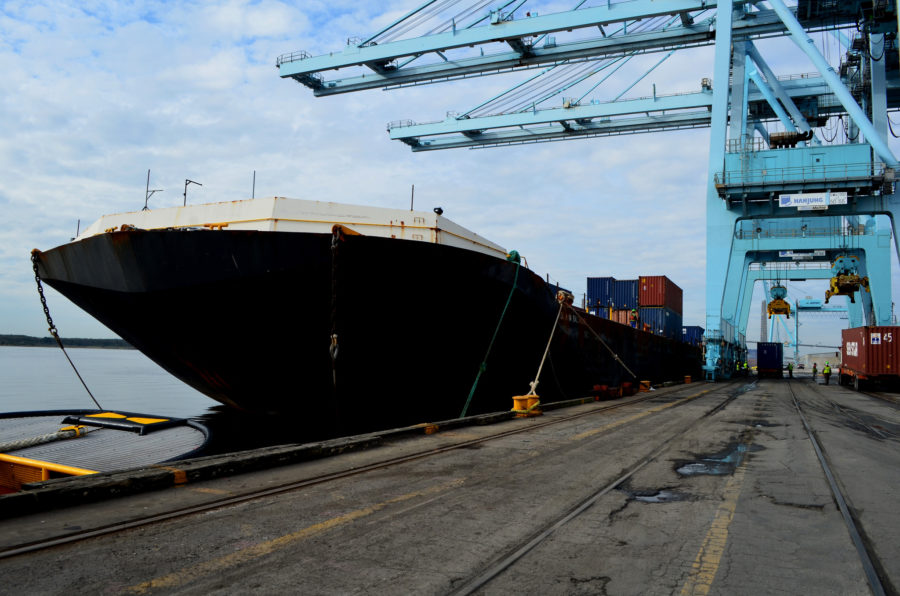Editor’s note: The graphic “Purpose of Proposed Tacoma LNG Facility” was updated 11/22/2017 to most accurately reflect language of source material.
The proposed Tacoma #LNG facility would defy numerous safety recommendations.
Puget Sound Energy (PSE), a regional utility, plans to build a multifarious liquefied natural gas (LNG) facility in Tacoma. The plant won the second of two leases the Tacoma Port Commission recently signed with companies promising to bring “clean energy” projects to the city. The other, now cancelled, was for a methanol project. The primary purpose is to produce LNG for fueling ships and heavy haul trucks, with a much smaller role of storing natural gas for distribution to utility customers on high demand days, known as “peak-shaving.” The multi-purpose nature of the proposed Tacoma facility sets it apart from any established LNG facility in the United States. It would defy numerous safety recommendations by operating at a busy port location and transport LNG in ways that are insufficiently regulated.
PSE operates an LNG storage facility in nearby Gig Harbor, Washington, but the utility is inexperienced in LNG production, and it has never operated a facility posing nearly as many hazards as would be present at Tacoma LNG. Additionally, LNG “bunkering”—providing LNG as fuel for ships—is a relatively new practice about which there are several gaps in regulations. The conditions at the Port of Tacoma, combined with the insufficient safety regulations and PSE’s inexperience, call for a critical examination that the project has yet to receive.
After a pushback in the facility’s targeted operations date from 2018 to 2019, regulators and community members have more time than they expected. It’s a valuable opportunity to consider each element of PSE’s project carefully and on its own merits, rather than fast-tracking a three-headed bunkering, trucking, and peak-shaving operation that could endanger the City of Destiny.
What is LNG bunkering?
A bunkering operation provides marine diesel fuel or LNG as fuel for ships. Bunkering can be conducted ship-to-ship or at a refueling pier through an LNG truck or pipeline. In a ship-to-ship bunkering operation, a ship or barge acts as a mobile gas station for another ship, meeting the vessel on the water to provide fuel. In truck-to-ship bunkering, an LNG tanker truck connects to the ship’s tank while the ship is docked. Bunkering LNG is a tricky enterprise because the cryogenic temperature of the fuel makes it harmful to people and structures and because LNG can rapidly change states from liquid to gas during transfer operations. (To better understand the complexity, see these sample safety checklists for ship-to-ship and truck-to-ship LNG bunkering.)
There is only one LNG bunkering facility operating in the US.
PSE claims that there are 100 facilities in the United States similar to the planned Tacoma project, but in fact there is only one bunkering facility operating in the United States. The Harvey Gulf LNG facility in Port Fourchon, Louisiana, a much less complex facility than the one proposed for Tacoma, only began operations in February 2015. About ten other projects have been proposed since 2013, but each is still in development and none are operational.

The proposed PSE facility at the Port of Tacoma would engage in at least two types of bunkering: pipeline bunkering for fueling project partner Totem Ocean Trailer Express’ (TOTE) cargo ships and barge bunkering for other ships. The details of PSE’s barge bunkering operations are thus far shrouded in mystery, and although the project’s Final Environmental Impact Statement (FEIS) states that two LNG tanker trucks per day would be filled at the facility, it is unclear whether the trucks would be used for truck-to-ship bunkering operations in Tacoma. The trucks could, however, travel from Tacoma to another location to engage in LNG bunkering.
Lack of regulations for bunkering operations
Regulators are still developing rules to govern LNG bunkering facilities. The Coast Guard is responsible for creating and enforcing national regulations for waterfront bunkering systems, processes, and procedures, as well as locations that are not waterfront facilities where tanker trucks are used to transfer LNG to marine vessels. To date, the Coast Guard has not issued any regulations on LNG marine bunkering. Existing Coast Guard regulations cover vessels that carry LNG as cargo, waterfront facilities that handle LNG as bulk cargo, and conventional oil bunkering operations but do not apply to LNG bunkering operations. Indeed, the FEIS for Tacoma LNG repeatedly references Coast Guard regulations that apply to LNG cargo operations but not to LNG bunkering.
The Coast Guard has issued policy letters on LNG bunkering that provide nonbinding guidance, and they make clear that following the guidance is voluntary. The policy letters could become law in the future, but it’s unclear how those laws would apply to projects that come online before the laws are established.
While the Coast Guard has not established national regulations, it participates in local decision-making by reviewing each waterfront LNG proposal, analyzing the suitability of the relevant waterway for LNG vessel traffic, and providing recommendations to state and local authorities concerning approval of the facility. The role of local authorities in the approval process can be riddled with conflict because they usually stand to gain financially from an LNG project. In Tacoma, for example, according to the lease agreement reached in August 2014 between the Port and PSE, the Port will earn up to $250,000 per month in rental income once the project is constructed and gain, for at least twenty-five years, a tenant that is willing to operate on a plot of highly polluted land that may be undesirable to many other businesses. The City of Tacoma has entered into a contract with PSE whereby the company will pay half the cost of one of the city’s several road and rail improvements projects at the Port of Tacoma, to the tune of five million dollars. Yet the Port and the city are the local authorities that are asked to oversee, and perhaps constrain through the permitting process, the very project that would provide such lucrative benefits.

Risks at a busy port
Even when operators observe the best practices for LNG bunkering, gas releases may occur as a part of normal LNG bunkering operations, making each operation a potential fire hazard. These gas releases present a particular danger when facilities are sited at busy ports, especially near other hazardous operations.
The Society for International Gas Tanker Terminal Operators advises in its publication LNG Operations in Port Areas that the most protected and secure location for an LNG port terminal is a remote area of the port that is not frequented by other port users. The shipping organization advises that when an LNG facility is sited in a developed port area, it becomes unavoidable that some or all of the best practices for siting an LNG facility will be compromised. The risk of compromising best practices is embodied quite clearly by Tacoma LNG: the facility would be flanked by two oil facilities (1, 2) on a busy industrial peninsula that is difficult to evacuate in an emergency and in close proximity to several marinas, unrelated ship traffic, and other port businesses and employees.
LNG operations present numerous hazards whether on land or at sea, and the American Bureau of Shipping identifies several risk factors specific to LNG bunkering, including:
- leaks from LNG pumps, pipes, hoses, or tanks;
- inadvertent disconnection of hoses;
- overfilling or over-pressuring vessel fuel tanks (including a well-documented hazard called rollover); and
- a forcible impact to the vessel.
Each location where bunkering takes place is considered a hazard area due to these risks, and the Tacoma LNG proposal includes three bunkering locations that would each have unique gas vapor release hazard zones. These three waterfront hazard areas are in addition to the fire hazard scenarios present at the land-based portions of the facility, which includes an eight-million gallon LNG tank, liquefaction equipment (which caused an explosion at an eastern Washington LNG facility in 2014), and three 4,500-gallon-capacity tanks storing propane, isopentane, and ethylene.
One of the project’s risk assessments identified the proposed refueling pier on the Blair Waterway, which would be used by TOTE for fueling its cargo ships, as a particularly hazardous bunkering site. Braemar Engineering found that in an emergency scenario at this pier, LNG vapors and thermal radiation would extend beyond the facility’s boundaries and affect workers at nearby businesses. (See FEIS section 3.5.7.) Cargo operations at this site increase the potential for uncontrolled sources of ignition because cargo transfer can produce sparks. Braemar Engineering’s risk analysis was unable to draw conclusions about the safety of the second proposed pier due to a lack of key design details as well as a lack of basic information about the size and frequency of ships that will be visiting the pier for LNG bunkering.
Tacoma officials should more closely examine each aspect of the three-headed project as the permitting process moves forward.
In addition to cargo operations, other ships pose an ignition risk to LNG bunkering. In fact, during ship-to-ship bunkering, both the supply vessel and receiving vessel pose an ignition risk. The best location is one where there is no possibility of other ships approaching, which would eliminate sources of ignition in the vicinity of the bunkering operation. Yet ships regularly approach and pass the locations where bunkering would take place at Tacoma.
To control the risk presented by other marine traffic, bunkering operations require a geographic safety perimeter that excludes other vessels and limits the speed and possibly the size of passing ships. The Coast Guard would determine the size of hazard zones and the acceptable length of time for which other vessels must be excluded from those zones. These restrictions would most likely limit ship traffic to and from other businesses on two Port waterways, and if the Coast Guard applies the best safety practices, it would likely impair normal operations of unrelated port business activities. This further underscores why busy ports are not good locations for LNG bunkering activities.
The documented discussions about the proposed Tacoma LNG facility indicate that local authorities lacked information about how this facility will differ from an LNG storage facility and was misinformed about the safety regulations that apply to PSE’s proposed activities. To protect public safety and other port businesses, Tacoma officials should more closely examine each aspect of the three-headed project as the permitting process moves forward, with greater transparency.
[button link='{“url”:”http://www.sightline.org/2016/01/13/tacoma-steering-into-uncertain-waters/”,”title”:”Like what you|apos;re reading? Find out more about the proposed LNG plant in Tacoma here.”}’ color=”green”]


Comments are closed.